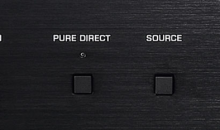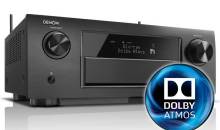Denon AVR Receivers Features Step-Chart
Everyone wants to buy the perfect A/V receiver. While you can run a comparison on Audiogurus.com, there are times when you already know what brand you want to buy—Denon for example—you just need to grasp the minor (or sometimes major) differences between the various models. That’s why we came up with these Step Charts to help you navigate your way through the various incremental (and sometimes monumental) steps between the models of current Denon receivers available for purchase. With our Step Charts and notes on what each break point brings you in terms of increased functionality or features, you can make a well-informed decision as to which receiver is going to best meet your needs.
Denon current has eight (8) receivers in its AVR lineup, and each model offers something new that you may or may not need or want for your home audio system. Some of these features are imperative for your system to work and sound as you intend, but other features are unnecessary unless you want to make use of the features they offer. Hopefully we can save you time, hassle and money—maybe all three.
Here is the Step Chart for the Denon AVR Series receivers:

Denon is no slouch when it comes to features, but some model numbers include more feature jumps than others.
Here are some of our more important notes:
Breakpoint 1: Streaming Services and Auto Setup
Denon’s AVR-E200 gets you int the door, but does almost nothing else. If you want automatic room setup or streaming media capabilities, you’re going to at least need to step up to the AVR-E300. It will give you AirPlay functionality as well as access to Spotify, Pandora and Sirius XM (if you have a subscription). It also lets you control the receiver using your smartphone (iOS or Android).
Breakpoint 2: Zone 2 and Component Video
If you need either component video support or the ability to send a discrete source to a second Zone, the AVR-E400 is your new best friend. You can do better, but this model is your gateway to whole home audio and legacy video support. Along with all this comes 7.1 functionality and two more channels of amplification. Oh, and a little hint—you probably don’t want to buy the AVR-X1000 receiver. While it may seem like an upgrade, it actually takes a couple steps back in the area of video upconversion and Zone 2 functionality. If you want the next serious upgrade from the AVR-E400, you’ll be looking all the way up at the AVR-X3000.
Breakpoint 3: RS-232C Control
We hardly want to include this breakpoint because it offers so little, but it may be an issue if you’re a custom installer. Aside from a bit more power, the next step up from the AVR-E400 is the AVR-X2000 which offers RS-232C control for more reliable and rock solid home automation. And aside from another year of warranty coverage, it honestly doesn’t offer much else. It even weighs less than the AVR-E400 and if you need a trigger output you still need to hit up the AVR-X3000.
Breakpoint 4: Dual Subs and Dual HDMI including Zone 2 Support
With dual HDMI outputs and HDMI support for Zone 2, the AVR-X3000 is a legitimate upgrade. More power and even a trigger out for connecting it to an external amplifier or other device (like an electric screen) make this a more capable AV receiver overall. There are also more inputs on this receiver, including more digital inputs and an additional component video input for legacy products. The AVR-X3000 also is the first Denon receiver in the current lineup to feature dual subwoofer outputs. Special Bonus Feature: Unusual among AV receivers, the AVR-X3000 provides a Zone 2 DAC, meaning that it will actually decode digital sources for the second zone. This is VERY unusual among AV receivers and a gem of a feature that means you don’t have to connect all of your sources via analogue audio cables to use them in your second zone.
Breakpoint 5: Component Video Out, Zone 3, More Power
The AVR-X4000 adds 20 watts per channel, no insignificant bump, as well as a component video output (perfect for running lag-free legacy gaming systems). It also gives you a third powered Zone option and introduces 9.2 preamp outputs for use with a more sophisticated outboard amplifier configuration. This is also one of only two current Denon receivers to include a Phono input (the other is the AVR-4520CI).
Breakpoint 6: Run Your Entire Home from a Single Box
If you want it all, the AVR-4520CI gives you three HDMI outputs (two in parallel and one for Zone 2) as well as a ton of more inputs and a full 150 watts per channel of amplification. The AVR-4520CI is, make no mistake, Denon’s current flagship AV receiver. The 5-series is due for an update and so the 4520CI reigns supreme. 11.2 preamp outputs, dual component video outputs and weighing 36.4 pounds, the 4520CI is a monster. Unfortunately, it doesn’t include the Zone 2 DAC found on the AVR-X3000 and AVR-X4000.
One thing to note about Denon’s current line-up of AV receivers is that NONE of them include the ability to handle a legacy device with multi-channel outputs. Not a single AVR receiver features a multi-channel input on the back. This is just something to keep in mind as you shop and compare brands.







Pingback: AVR Recs
not seeing anything on Netflix streaming. Doesthe 7200 have that capability?
It does not. The video streaming services seem to be disappearing from receivers.
How to add an amp to avrs510bt